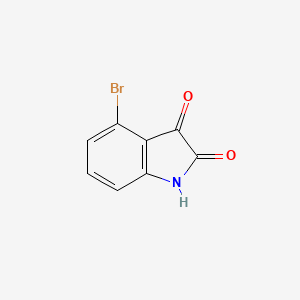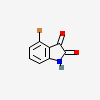4-Bromoisatin
- 4-bromoisatin
- 20780-72-7
- 4-bromo-1H-indole-2,3-dione
- 4-bromoindoline-2,3-dione
- 1H-Indole-2,3-dione, 4-bromo-
- Create:2005-09-15
- Modify:2025-01-18

- 4-bromoisatin
- 20780-72-7
- 4-bromo-1H-indole-2,3-dione
- 4-bromoindoline-2,3-dione
- 1H-Indole-2,3-dione, 4-bromo-
- 4-Bromoindole-2,3-dione
- MFCD03618555
- 4-Bromo-Isatin
- 4-bromo-2,3-dihydro-1H-indole-2,3-dione
- 4-BROMO-2,3-INDOLINEDIONE
- SCHEMBL281203
- CHEMBL226658
- DTXSID60403730
- CHEBI:149871
- ALBB-002982
- BCP22780
- STR08947
- BBL016802
- STK434994
- AKOS000266239
- AB15602
- AC-3166
- BCP9000157
- CS-W008631
- FS-2679
- SY004146
- 4-Bromo-1H-indole-2,3-dione, AldrichCPR
- DB-026190
- B2423
- EN300-24131
- J-514819
- Z169511486

H302 (22.2%): Harmful if swallowed [Warning Acute toxicity, oral]
H312 (22.2%): Harmful in contact with skin [Warning Acute toxicity, dermal]
H315 (33.3%): Causes skin irritation [Warning Skin corrosion/irritation]
H319 (33.3%): Causes serious eye irritation [Warning Serious eye damage/eye irritation]
H332 (22.2%): Harmful if inhaled [Warning Acute toxicity, inhalation]
H335 (22.2%): May cause respiratory irritation [Warning Specific target organ toxicity, single exposure; Respiratory tract irritation]
P261, P264, P264+P265, P270, P271, P280, P301+P317, P302+P352, P304+P340, P305+P351+P338, P317, P319, P321, P330, P332+P317, P337+P317, P362+P364, P403+P233, P405, and P501
(The corresponding statement to each P-code can be found at the GHS Classification page.)
Aggregated GHS information provided per 9 reports by companies from 4 notifications to the ECHA C&L Inventory. Each notification may be associated with multiple companies.
Reported as not meeting GHS hazard criteria per 6 of 9 reports by companies. For more detailed information, please visit ECHA C&L website.
There are 3 notifications provided by 3 of 9 reports by companies with hazard statement code(s).
Information may vary between notifications depending on impurities, additives, and other factors. The percentage value in parenthesis indicates the notified classification ratio from companies that provide hazard codes. Only hazard codes with percentage values above 10% are shown.
Acute Tox. 4 (22.2%)
Acute Tox. 4 (22.2%)
Skin Irrit. 2 (33.3%)
Eye Irrit. 2A (33.3%)
Acute Tox. 4 (22.2%)
STOT SE 3 (22.2%)
Patents are available for this chemical structure:
https://patentscope.wipo.int/search/en/result.jsf?inchikey=ITRAKBJPMLKWIW-UHFFFAOYSA-N
- ChEBI
- ChEMBLLICENSEAccess to the web interface of ChEMBL is made under the EBI's Terms of Use (http://www.ebi.ac.uk/Information/termsofuse.html). The ChEMBL data is made available on a Creative Commons Attribution-Share Alike 3.0 Unported License (http://creativecommons.org/licenses/by-sa/3.0/).http://www.ebi.ac.uk/Information/termsofuse.htmlChEMBL Protein Target Treehttps://www.ebi.ac.uk/chembl/g/#browse/targets
- Crystallography Open Database (COD)LICENSEAll data in the COD and the database itself are dedicated to the public domain and licensed under the CC0 License. Users of the data should acknowledge the original authors of the structural data.https://creativecommons.org/publicdomain/zero/1.0/
- EPA DSSTox4-bromoisatinhttps://comptox.epa.gov/dashboard/DTXSID60403730CompTox Chemicals Dashboard Chemical Listshttps://comptox.epa.gov/dashboard/chemical-lists/
- European Chemicals Agency (ECHA)LICENSEUse of the information, documents and data from the ECHA website is subject to the terms and conditions of this Legal Notice, and subject to other binding limitations provided for under applicable law, the information, documents and data made available on the ECHA website may be reproduced, distributed and/or used, totally or in part, for non-commercial purposes provided that ECHA is acknowledged as the source: "Source: European Chemicals Agency, http://echa.europa.eu/". Such acknowledgement must be included in each copy of the material. ECHA permits and encourages organisations and individuals to create links to the ECHA website under the following cumulative conditions: Links can only be made to webpages that provide a link to the Legal Notice page.https://echa.europa.eu/web/guest/legal-notice4-Bromoisatin (EC: 640-250-3)https://echa.europa.eu/information-on-chemicals/cl-inventory-database/-/discli/details/172758
- Japan Chemical Substance Dictionary (Nikkaji)
- SpectraBase4-Bromoisatinhttps://spectrabase.com/spectrum/FgxWvP6RcLG
- Springer Nature
- Thieme ChemistryLICENSEThe Thieme Chemistry contribution within PubChem is provided under a CC-BY-NC-ND 4.0 license, unless otherwise stated.https://creativecommons.org/licenses/by-nc-nd/4.0/
- Wikidata4-Bromoisatinhttps://www.wikidata.org/wiki/Q72445779
- Wiley
- PubChem
- GHS Classification (UNECE)GHS Classification Treehttp://www.unece.org/trans/danger/publi/ghs/ghs_welcome_e.html
- MolGenieMolGenie Organic Chemistry Ontologyhttps://github.com/MolGenie/ontology/
- PATENTSCOPE (WIPO)SID 389027864https://pubchem.ncbi.nlm.nih.gov/substance/389027864

